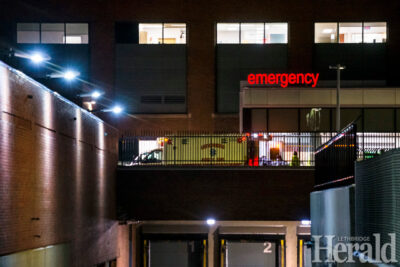Hospital capacity in city ‘very stretched’: AHS
By Lethbridge Herald on December 6, 2022.
 An ambulance unloads a patient outside of the emergency department Tuesday evening at the Chinook Regional Hospital. The city’s hospital capacity is being stretched, says the AHS South Zone Medical Director Dr. Aaron Low. Herald photo by Ian Martens
An ambulance unloads a patient outside of the emergency department Tuesday evening at the Chinook Regional Hospital. The city’s hospital capacity is being stretched, says the AHS South Zone Medical Director Dr. Aaron Low. Herald photo by Ian MartensAl Beeber – LETHBRIDGE HERALD – abeeber@lethbridgeherald.com
Chinook Regional Hospital is being stretched to capacity but no patients have been transferred to other facilities, Dr. Aaron Low of Alberta Health Services said Tuesday.
Low, the AHS South Zone Medical Director, who works in critical care at the hospital, said for a period of several hours on the weekend it was in a position – because of staff unavailability – where if it had received more patients to the intensive care unit the hospital would have diverted them elsewhere. That staffing shortage was primarily nursing staff.
The CHR ICU unit has space for 20 patients and in the last two days, 16-17 beds have been filled. Between 13-14 have been on mechanical ventilation and with such high acuity, one-on-one patient care is needed, said Low.
Low said he expects the high volume to be short-term as the impact of the flu season is reduced.
The vaccination rate for influenza in the South Zone is about 21 per cent, which Low said is a figure similar to those elsewhere in the province.
Influenza strains currently circulating are more severe which is partly the reason for the severe viral load that’s being seen in Alberta, he added.
Low said vaccinations are important for influenza especially with younger and older patients who are mostly the patients the CHR sees being admitted.
“Our hospital capacity in Lethbridge is very stretched. We have as of now not had to transfer any patients out who would have required critical care or care for any reason. We’ve been able to deal with all the patients that have presented,” said Low in a Zoom meeting with media.
“But that is something that we’re actively on so that we have appropriate staffing to be able to provide the care that’s required,” he said.
On the weekend for several hours, the hospital put in place a process that if it had “received any additional ICU-level patients we would have diverted them. We didn’t have to do that but for a brief period of time we almost had to do that” due to staffing, not beds, he said.
Low said “it’s not uncommon for us as a regional centre to send patients to another hospital such as Calgary because of patients’ acuity or condition. It’s a normal practice,” he stated, referring to patients who require cardiac, vascular or neuro surgery who are routinely transferred to Calgary.
“What we would have had to do this weekend would have been to transfer somebody for something that we normally would have done here,” Low said.
Twenty spaces exist in ICU but “it’s difficult for us to staff up that number of patients. Officially, 16 of those beds are ICU and four of those are CCU” for cardiac and other patients, he said.
The 16-17 in the ICU that the hospital has seen the past two days are “a stretch for us. We are working and planning proactively to manage so we do have staff available for this number of patients.
“This is not an exceptional circumstance, actually in the province or across the country where, as you are aware, lots of hospitals are seeing more respiratory illness and generally increased demand for people who have severe illness,” added Low.
“Like other places we are also dealing with significant staffing challenges,” which also isn’t a new thing, said Low.
The hospital works to ensure it has adequate capacity for patients, he added, and works with other sites within the zone and province to ensure there is capacity to safely take patients from one site to another.
Low said the vast majority of viral illness now is influenza although there are others including RSV. Some COVID exists “but not tons,” he added.
The capacity situation affects the whole hospital, he said, including medical floors.
The hospital has added additional capacity on medical floors “where we have been in something called over-capacity where we add additional spaces.”
Low said hospitals in Alberta and Canada generally operate at “very close to capacity. We don’t have 20 per cent beds for example that we keep just in case.”
“So it doesn’t take many extra patients for us to be in a tight spot. I do think this volume though is very high and is very likely to be short-term as hopefully our flu season reduces and we get through that.”
In response to a question, Low said despite an obstetrician shortage in Lethbridge any pregnant woman who goes to CHR will get the care she needs. He said a pool of more than 20 obstetricians, mostly in Calgary, are available to ensure patients get the excellent care they need.
In a media statement, NDP MLA for Lethbridge West Shannon Phillips called for immediate action from the UCP government to address health care in light of the CHR situation.
“The UCP’s war on doctors has caused catastrophic harm to families in Lethbridge,” Phillips said. “The UCP have failed to address problems of their own making. The community of Lethbridge deserves better than this which is why we need a new government,” Phillips added.
Follow @albeebHerald on Twitter
28-27


